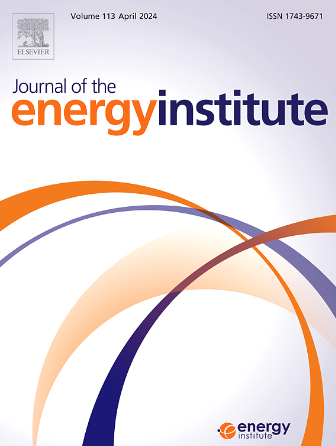Effects of carbon dioxide addition on soot dynamics in ethylene/air inverse diffusion flames: An experimental and computational analysis
IF 5.6
2区 工程技术
Q2 ENERGY & FUELS
引用次数: 0
Abstract
The effects of carbon dioxide (CO2) addition to ethylene (C2H4)/air inverse diffusion flames (IDFs) to the air stream on soot formation characteristics are investigated with the addition ratio of 0–13.64 %. The planar laser-induced fluorescence (PLIF) and planar laser-induced incandescence (PLII) techniques, in conjunction with CoFlame and Chemkin code simulations were utilized to assess the distributions of Polycyclic Aromatic Hydrocarbons (PAHs) and Soot Volume Fraction (SVF). The findings indicate that increasing CO2 addition results in a gradual decrease in the mole fraction of hydroxyl (OH) radicals and flame temperature, accompanied by a reduction of approximately 15 % in the reaction zone height in experimental observations and 19 % in simulations. The inhibition of soot formation is evident through a consistent decline in the normalized total SVF, a decrease in the peak volume fraction of radial soot distribution, and reduced total SVFs observed across different flame sections at varying heights. In the meanwhile, increasing the CO2 doping ratio significantly reduces the peak signal intensity of PAHs, particularly affecting high molecular weight PAHs (A3-A4, A2-A3) with reductions of up to 75.5 %. Furthermore, reductions are noted in the rates of soot inception and subsequent surface growth, accompanied by an upward displacement of the initial inception and growth location. The condensation of PAHs controls the soot surface growth. The thermal and chemical effects of CO2 were differentiated by employing the virtual substance FCO2. The results suggest that the thermal effect of CO2 lowers flame temperature, reduces combustion intensity, and consequently inhibits soot nucleation. The chemical effect of CO2 competes for H radicals through the reverse reaction of CO + OH ≤> CO2+H. This process suppresses the formation and growth of PAHs, consequently leading to a reduction in soot production.
添加二氧化碳对乙烯/空气反向扩散火焰中烟尘动力学的影响:实验和计算分析
研究了向乙烯(C2H4)/空气反向扩散火焰(IDF)气流中添加二氧化碳(CO2)对烟尘形成特性的影响,添加比例为 0-13.64%。利用平面激光诱导荧光(PLIF)和平面激光诱导炽热(PLII)技术以及 CoFlame 和 Chemkin 代码模拟来评估多环芳烃(PAHs)和烟尘体积分数(SVF)的分布。研究结果表明,二氧化碳添加量的增加会导致羟基(OH)自由基的摩尔分数和火焰温度逐渐降低,同时在实验观察中反应区高度降低了约 15%,在模拟中降低了 19%。在不同高度的火焰截面上观察到的归一化总 SVF 持续下降、径向烟尘分布的峰值体积分数降低以及总 SVF 减少,都表明烟尘的形成受到了抑制。同时,二氧化碳掺杂率的增加会显著降低多环芳烃的峰值信号强度,尤其是对高分子量多环芳烃(A3-A4、A2-A3)的影响,降低幅度高达 75.5%。此外,烟尘的萌发率和随后的表面生长率也有所降低,最初的萌发和生长位置也随之上移。多环芳烃的凝结控制了烟尘的表面生长。通过使用虚拟物质 FCO2,对二氧化碳的热效应和化学效应进行了区分。结果表明,二氧化碳的热效应降低了火焰温度,降低了燃烧强度,从而抑制了烟尘成核。CO2 的化学效应通过 CO + OH ≤> CO2+H 的逆反应竞争 H 自由基。这一过程抑制了多环芳烃的形成和增长,从而减少了烟尘的产生。
本文章由计算机程序翻译,如有差异,请以英文原文为准。
求助全文
约1分钟内获得全文
求助全文
来源期刊

Journal of The Energy Institute
工程技术-能源与燃料
CiteScore
10.60
自引率
5.30%
发文量
166
审稿时长
16 days
期刊介绍:
The Journal of the Energy Institute provides peer reviewed coverage of original high quality research on energy, engineering and technology.The coverage is broad and the main areas of interest include:
Combustion engineering and associated technologies; process heating; power generation; engines and propulsion; emissions and environmental pollution control; clean coal technologies; carbon abatement technologies
Emissions and environmental pollution control; safety and hazards;
Clean coal technologies; carbon abatement technologies, including carbon capture and storage, CCS;
Petroleum engineering and fuel quality, including storage and transport
Alternative energy sources; biomass utilisation and biomass conversion technologies; energy from waste, incineration and recycling
Energy conversion, energy recovery and energy efficiency; space heating, fuel cells, heat pumps and cooling systems
Energy storage
The journal''s coverage reflects changes in energy technology that result from the transition to more efficient energy production and end use together with reduced carbon emission.
 求助内容:
求助内容: 应助结果提醒方式:
应助结果提醒方式:


